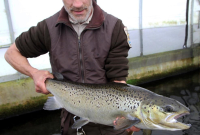Support strong Canadian climate journalism for 2025
If you're planning to enjoy the great outdoors this summer, there are good reasons to stock up on bug spray.
The latest edition of a national report on wild species in Canada shows there are 160 different species of blackflies and 80 different species of mosquitoes in the country and the majority of them are flourishing.
Wild Species 2015, is the fourth version of a report on the general status of species in Canada which is required every five years under Species at Risk Act.
The report collected data from provincial and federal departments which monitor wildlife, assessing nearly 30,000 of the country's 80,000 known species, ranging from mammals and reptiles to lichens and insects.
Dan Kraus, national conservation biologist with the Nature Conservancy of Canada, said the report is a pretty good check list on the status of about one-third of the wild species in Canada.
"Which is pretty good although, you know, here we are one of the wealthiest countries in the world and we can't even assess the status of over half the wild species that occur here," he said. "It's good progress but clearly there is a lot of work to be done."
The 2015 report assessed more than twice as many species as the 2011, report, when fewer than 12,000 species were looked at closely. In 2000, when the first version was completed, only 1,670 species were assessed.
The 2015 report lists 122 species which are extinct or possibly extinct in Canada including the black footed ferret, Blanchard's cricket frog and the frosted elfin butterfly.
There are 39 insects on this list — three butterflies, two kinds of ants, 22 different beetles, and 10 grasshoppers. To every camper's frustration, there are no mosquitoes or blackflies among them.
There are 456 species in critical danger of going extinct in Canada including the common grey fox, the eastern prickly pear cactus, the spruce-fir moss tarantula and the Oregon spotted frog.
There are 88 insects on the critically imperilled list but again no mosquitoes or blackflies. One species of blackfly is on the verge of being labelled critically imperilled, and four are imperilled, but 106 of the 160 species of blackflies are considered to be secure. Another 42 are unranked because there isn't enough information about them to determined their status.
Of the 80 types of mosquitoes, 65 are secure, while 12 are unranked.
There are 11 yellowjacket wasps considered at risk, out of more than 100 different species of wasps.
Threats to wild life in Canada take many forms including habitat encroachment, pollution and disease. According to the report, the American black bear is secure, but both the polar bear and the grizzly bear are vulnerable.
Canada's fabled beaver is also doing just fine.
Of species which were given a ranking and are not extinct, they are assessed on a scale of one to five, with one being critically imperilled and five being secure. Level three is considered vulnerable.
Kraus said one of the species that jumped out at him for its changed ranking was the early hairstreak butterfly, which is now considered imperilled. The butterfly feeds on beech trees and those trees are in trouble because of an invasive disease which is leaving the butterfly at risk, he said.





Comments